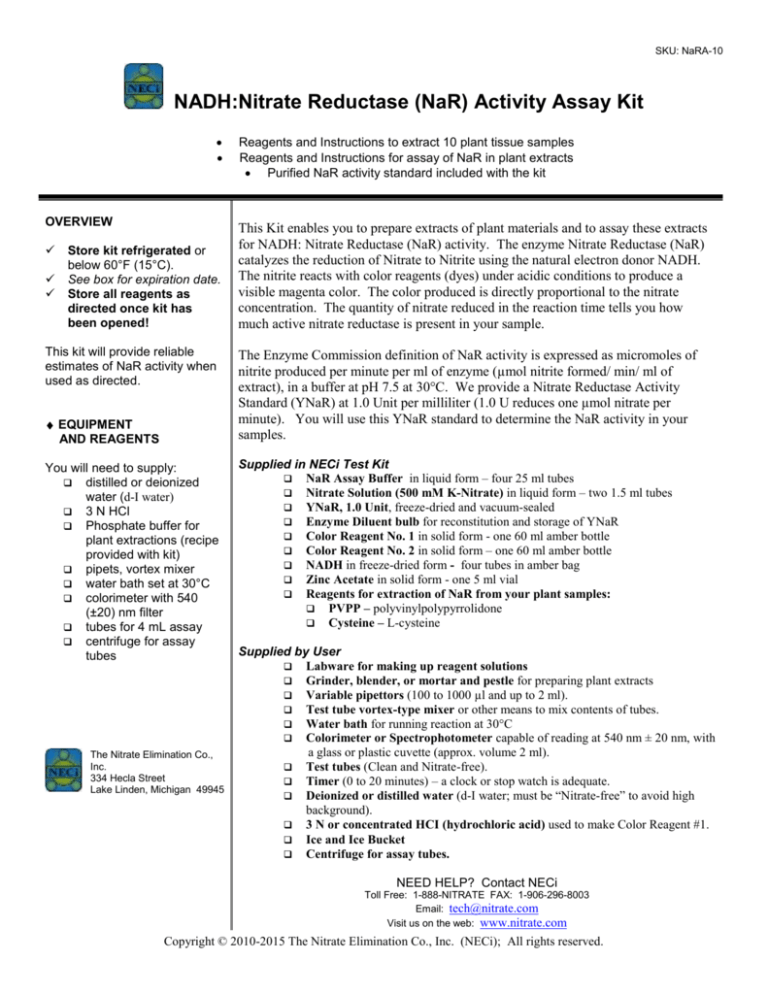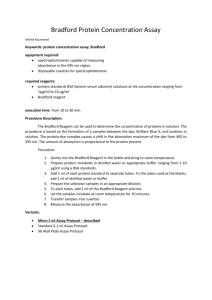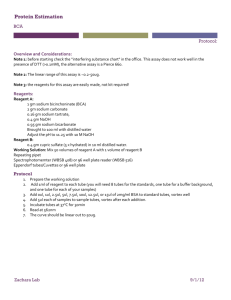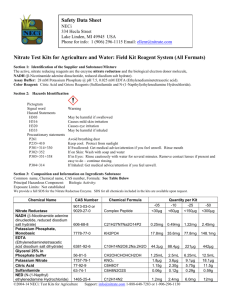
SKU: NaRA-10
NADH:Nitrate Reductase (NaR) Activity Assay Kit
OVERVIEW
Store kit refrigerated or
below 60°F (15°C).
See box for expiration date.
Store all reagents as
directed once kit has
been opened!
This kit will provide reliable
estimates of NaR activity when
used as directed.
EQUIPMENT
AND REAGENTS
You will need to supply:
distilled or deionized
water (d-I water)
3 N HCl
Phosphate buffer for
plant extractions (recipe
provided with kit)
pipets, vortex mixer
water bath set at 30°C
colorimeter with 540
(±20) nm filter
tubes for 4 mL assay
centrifuge for assay
tubes
The Nitrate Elimination Co.,
Inc.
334 Hecla Street
Lake Linden, Michigan 49945
Reagents and Instructions to extract 10 plant tissue samples
Reagents and Instructions for assay of NaR in plant extracts
Purified NaR activity standard included with the kit
This Kit enables you to prepare extracts of plant materials and to assay these extracts
for NADH: Nitrate Reductase (NaR) activity. The enzyme Nitrate Reductase (NaR)
catalyzes the reduction of Nitrate to Nitrite using the natural electron donor NADH.
The nitrite reacts with color reagents (dyes) under acidic conditions to produce a
visible magenta color. The color produced is directly proportional to the nitrate
concentration. The quantity of nitrate reduced in the reaction time tells you how
much active nitrate reductase is present in your sample.
The Enzyme Commission definition of NaR activity is expressed as micromoles of
nitrite produced per minute per ml of enzyme (µmol nitrite formed/ min/ ml of
extract), in a buffer at pH 7.5 at 30°C. We provide a Nitrate Reductase Activity
Standard (YNaR) at 1.0 Unit per milliliter (1.0 U reduces one µmol nitrate per
minute). You will use this YNaR standard to determine the NaR activity in your
samples.
Supplied in NECi Test Kit
NaR Assay Buffer in liquid form – four 25 ml tubes
Nitrate Solution (500 mM K-Nitrate) in liquid form – two 1.5 ml tubes
YNaR, 1.0 Unit, freeze-dried and vacuum-sealed
Enzyme Diluent bulb for reconstitution and storage of YNaR
Color Reagent No. 1 in solid form - one 60 ml amber bottle
Color Reagent No. 2 in solid form – one 60 ml amber bottle
NADH in freeze-dried form - four tubes in amber bag
Zinc Acetate in solid form - one 5 ml vial
Reagents for extraction of NaR from your plant samples:
PVPP – polyvinylpolypyrrolidone
Cysteine – L-cysteine
Supplied by User
Labware for making up reagent solutions
Grinder, blender, or mortar and pestle for preparing plant extracts
Variable pipettors (100 to 1000 µl and up to 2 ml).
Test tube vortex-type mixer or other means to mix contents of tubes.
Water bath for running reaction at 30°C
Colorimeter or Spectrophotometer capable of reading at 540 nm ± 20 nm, with
a glass or plastic cuvette (approx. volume 2 ml).
Test tubes (Clean and Nitrate-free).
Timer (0 to 20 minutes) – a clock or stop watch is adequate.
Deionized or distilled water (d-I water; must be “Nitrate-free” to avoid high
background).
3 N or concentrated HCI (hydrochloric acid) used to make Color Reagent #1.
Ice and Ice Bucket
Centrifuge for assay tubes.
NEED HELP? Contact NECi
Toll Free: 1-888-NITRATE FAX: 1-906-296-8003
Email: tech@nitrate.com
Visit us on the web: www.nitrate.com
Copyright © 2010-2015 The Nitrate Elimination Co., Inc. (NECi); All rights reserved.
Page 2
REAGENT
NECi NADH: NaR Activity Assay Kit
PREPARATION
Store Assay Buffer and
Color Reagents at 4°C
between uses.
Store YNaR standard and
NADH solutions at -20°C.
NOTES ON THE
REAGENTS
CAUTION: Color Reagent
#1 is made with HCl!
Use standard
precautions for handling
acids. Pipet with care.
Zinc Acetate solution is
corrosive. Don’t leave the
wet tip on your pipettor.
************************
PREPARATION
of PLANT
EXTRACTION
BUFFER
We do not supply the
plant extraction buffer.
Additives to protect
nitrate reductase activity
ARE supplied in the kit.
Add these to your buffer
as directed here.
(SKU: NaRA-10)
1. NaR Assay Buffer: Add nitrate before use! Warm to room temperature and add 1 ml
of Nitrate Solution to 50 mL of buffer, and mix. Prepare 50 ml of NaR Assay Buffer
+ Nitrate at a time. (Use 2 x25mL buffer.) Repeat as needed. Store at 4°C.
2. Color Reagent #1: Prepare 3 N HCI by adding 15 ml concentrated HCI to 45 ml
d-I water. Mix. Add 3 N HCI to Color Reagent No. 1 bottle. Mix by inverting
several times until all the solid dissolves. Store at 4°C.
3. Color Reagent #2: Add 60 ml d-I water to Color Reagent No. 2 bottle. Mix by
inverting several times until all the solid dissolves. Store at 4°C.
4. NADH solution: Remove 1 tube of NADH from amber bag, tap tube to settle
contents. Add 1.5 ml d-I water and replace cap. Mix gently with vortex-type mixer.
Keep on ice during use. Freeze between uses.
5. YNaR nitrate reductase standard solution: Twist end off Enzyme Diluent bulb
and squeeze contents into YNaR vial. Let stand 10 minutes, mix gently at 5 minute
intervals. Keep on ice during use and store at -20°C.
6. Zinc Acetate: Add 5.0 ml d-I water to ZnAc vial (plastic bottle with white cap)
Final concentrations of Reagents:
Assay Buffer - 25 mM KH2PO4, 0.025 mM EDTA; pH 7.5.
Assay Buffer will contain 10 mM Nitrate after KNO3 is added.
Color Reagent No. 1 - 1% Sulfanilamide in 3 N HCl.
Color Reagent No. 2 - 0.02% N-Naphthylethylenediamine in d-I water.
NADH – approx. 2 mM NADH – once the dry form is in solution.
YNaR – Nitrate reductase, 1.0 U/ml
ZnAc – 1 M Zinc acetate
****************************************************************************
Nitrate Reductase Extraction Buffer:
We recommend 0.1 M Potassium Phosphate containing 1 mM EDTA, pH 7.5. Use
Reagent Grade or better. You can substitute a sodium phosphate or MOPS buffer. DO
NOT use Tris buffer.
RECIPE FOR ONE LITER OF EXTRACTION BUFFER:
13.6 g KH2PO4 (potassium phosphate, monobasic)
370 mg Na2EDTA (EDTA, sodium salt)
5 g KOH (potassium hydroxide)
Make up to 1 liter using d-I water, mix thoroughly and adjust pH. The pH will be about
7.5, but be sure to check and adjust as necessary. You don’t need to be exact here. Volume
should be 1 liter ± 10%, pH range between 7.0 – 7.8 is OK for nitrate reductase.
Store buffer at 4°C and
use cold for extraction.
We recommend a ratio of four milliliters of extraction buffer per gram of plant tissue (wet
weight). We recommend using 10 grams of sample per extraction, if enough material is
available, so that you have a representative sample. You will add the PVPP and Cysteine
when you are ready to grind the tissues in the extraction buffer.
The Nitrate Elimination Co., Inc.
334 Hecla Street
Lake Linden, Michigan 49945
Nitrate reductase is a very sensitive and unstable enzyme. The PVPP will protect the
enzyme from phenolic compounds. The Cysteine protects sulfhydryl groups that are
critical for enzyme structure. We do NOT provide any protease inhibitors with this kit. If
your sample type is known to have strong protease activity, consult the literature for the
appropriate inhibitor and add to the extraction buffer immediately before use.
Copyright © 2010-2015 The Nitrate Elimination Co., Inc. (NECi); All rights reserved.
Page 3
NECi NADH: NaR Activity Assay Kit
PLANT
EXTRACTION
PROCEDURE
For best results, keep
everything cold: use
an ice bucket, start
with solutions at 4°C,
work in a cold room.
Keep solutions and
vessels in a
refrigerator until use.
We recommend 10
grams of plant material
to 40 ml of extraction
buffer. If sample size is
limited, reduce all
ingredients
proportionately to suit
your sample size.
For quantitative results,
measure the volume of
each plant extract. Use
this value in Calculations
on Page 4.
(SKU: NaRA-10)
There are many methods for preparation of plant extracts. A standard kitchen or lab
blender, or mortar and pestle may be used. It is important to have all containers and
reagents cold when you begin the extraction. This will help preserve enzyme activity.
Start with freshly cut plant materials whenever possible. If samples must be shipped
and/or stored, use dry ice or store at -70°C. Liquid nitrogen is also fine.
Suggested protocol:
10 g of your plant material (freshly cut or frozen)
40 ml chilled Extraction Buffer (prepared above)
0.4 g PVPP (provided with kit)
0.03 g L-Cysteine (provided)
1. Combine ingredients into a chilled blender vessel and grind until mixture consists of a slurry
of uniform small particle size – approx one minute at high speed. Be sure the PVPP and
Cysteine are mixed into the slurry – PVPP will not go into solution.
2. Filter the slurry through 2-4 layers of cheesecloth, Miracloth or equivalent.
3. Optional: Centrifuge at 4°C 10,000 rpm/10 min
4. Repeat for each sample. Keep samples on ice until ready to assay. Do not freeze!
Alternate: Use mortar and pestle. The extraction will be more uniform if you start with
frozen materials. Dry ice or liquid nitrogen may be used. Follow steps as listed above.
Note: You can use smaller quantities of plant material if sample is limited. Retain the ratio
of 4 volumes of Extraction Buffer to gram of plant material, and reduce the PVPP and Cysteine
proportionately. A little too much of either does no harm.
*******************
**********************************************************************************
NaR Activity
Assay using YNaR
standard
Nitrate Reductase Activity assay using Purified YNaR Standard
This section is
optional. We include
it to allow you to
practice the NaR
assay.
Have Assay Buffer at
room temp before you
begin the assay
procedure. Saves
time!
***************
NaR ACTIVITY
ASSAY
We provide this protocol as a reality check. Test that all assay reagents are ready to use and get some
familiarity with the NaR assay before you waste any precious samples!
1. Label 4 tubes: #1 is your Reagent Blank. Set tubes in water bath at 30°C.
2. Add 1.8 ml Assay Buffer to each tube. Allow enough time for Assay Buffer to reach 30°C.
3. Add 100 µl YNaR solution to each tube. Mix. Do not add NADH to Tube #1!
4. This is where the timing begins, so have your stopwatch or clock in eyesight. Add 100 µl NADH to
tubes #2 – 4. Note exact time you add the NADH to each tube! Mix gently. Leave 10 – 15
seconds between tubes to give yourself time for Step 5. The YNaR will begin to reduce nitrate the
instant NADH is added!
5. At exactly one minute (60 seconds) STOP the reaction by adding 1ml of Color Reagent #1 to
EACH tube. Mix. (This is why it is important to stagger the addition of NADH in Step 4.)
6. Add 1ml Color Reagent #2 to all tubes. Mix.
7. Read absorbance at 540nm. Absorbance should be low or Zero for tube #1 (the Blank), and
approx 1.0 for tubes #2-4 (the YNaR standard). If absorbance is higher than 0.030 for the Blank,
there is nitrate or nitrite in your water, glassware, or something else in your lab.
******************************************************************************
Assay Nitrate Reductase Activity in your Samples
Here’s where you
assay the NaR
activity in your plant
extracts.
Part I: nitrate
reduction
Have water bath ready
at 30°C. Have Assay
Buffer at room temp.
Part I: nitrate reduction step
These steps allow the enzyme to react and remove protein interferences.
1. For each sample to be analyzed:
a. Label 4 microfuge tubes. #1 = Blank; #2 = 5 minute time point, #3 – 10 min, #4 =
15 min. This allows you to get a useable result when NaR activity is low. Set tubes
in water bath at 30°C.
b. Add 1.8 ml Assay Buffer to each tube.
c. Add 100 µl of your plant extract to each tube. Mix.
d. Set #1, the Blank, aside
2. This is where timing begins, so have your stopwatch or clock in view. Add 100 µl NADH to
tubes #2-4. Mix. Allow each tube to react for correct number of minutes.
3. Stop reaction by adding 100 µl ZnAc to tube #2 at 5 min, #3 at 10 min, #4 at 15 min. Add
ZnAc to tube #1 at any time. Mix thoroughly after adding the ZnAc.
4. Centrifuge tubes to remove precipitate. Two – 5 min at 5000 rpm, longer at slower rpm.
Copyright © 2010-2015 The Nitrate Elimination Co., Inc. (NECi); All rights reserved.
Page 4
NECi NADH: NaR Activity Assay Kit_
(SKU: NaRA-10)
Assay Nitrate Reductase Activity in your samples, Part II:
NaR ACTIVITY
ASSAY PART II:
COLOR
DEVELOPMENT
AND
CALCULATIONS
Color Development
5. Pour supernatant from Step 4 tubes into clean, labeled tubes.
6. Add 1ml Color Reagent #1 to each tube. Mix.
7. Add 1ml Color Reagent #2 to each tube. Mix. Allow 10 minutes for color to develop
fully. The Blank tube should be nearly colorless.
8. Read absorbance at 540 nm (± 20nm). Use d-I water to zero the colorimeter or
spectrophotometer. Rinse cuvette with d-I water between samples.
Calculations:
1. Deduct the absorbance you got for your Blank from the absorbance of the samples. This
corrects for any nitrite that may be present in your plant extracts.
2. Divide each time point to get absorbance per minute.
a. Example: (A540 tube #2 – A540 tube #1)/5 min
WASTE DISPOSAL
Follow all local
guidelines and
regulations. If there are
no local guidelines, wash
the waste down the sink
with large amounts of
running water.
3. Average the time points from all three tubes. Reject any data points with absorbance
higher than 1.5AU. This gives you average change in absorbance per minute.
4. Now you can determine NaR activity in Units/ml:
Average change in A540/min = Units/ml
Example: If average A540/min is 0.014, then Units/ml = 0.014 U/ml
5. NaR activity is generally expressed as µmol nitrite produced per hour per gram
fresh weight of plant material in plant extracts. Here’s how to calculate µmol/hr/gfw:
For the example above, take the original total volume of the plant extract (assume ~45ml
if you haven’t measured it):
45 ml(0.014 U/ml) = 0.63U total in the plant extract
(Total units)(60 min) = 0.63(60) = 3.78 µmol/hr/gfw
grams plant material
10 g
**************************************************************************
NECi
334 Hecla Street
Lake Linden, Michigan 49945
NOTES: If your NaR source has high NaR activity, your A540 for the longer time points will be > 1.5.
In that case, use shorter time points (e.g 1,2,3 minutes). If your A 540 values are too low, your plant
materials have low NaR activity. In such cases, increase your time points (10,20,30 min).
To test whether your extracts inhibit NaR: If you consistently see little or no NaR activity, there
may be proteases or inhibitors of NaR in your plant extracts. An easy test of this is to add 100 µl
YNaR standard to one of your extracts (NaR “spike”). Do a one minute assay as directed on the
bottom section of Page 3. If you do not see A540 of at least 1.0, something in your extract inhibits or
destroys NaR. Consult the literature for NaR assays for your specific plant material. You may need to
add protease inhibitors, FADH, Dithiothreitol or other additives during your extraction procedure.
This kit will NOT detect NADPH NaR Activity unless you substitute your own NADPH for the supplied NADH.
Thanks for using our products. Call Tech Support: 1.906.296.1130, or visit the NECi website: www.nitrate.com if you need more information.
We’re always interested in hearing about your experience with our kits.
NECi, The Nitrate Elimination Co., Inc.: Biotechnology People Can Use!
NECi, 334 Hecla Street, Lake Linden, MI 49945 USA
Limited warranty: The Nitrate Elimination Co, Inc (NECi) warrants at the time of shipping that this product was free from defects in the materials supplied in the Nitrate Reductase
(NADH:NaR) Assay Kit. NECi warrants that the reagents supplied will be effective for use in NaR activity testing when used as described until the expiration date, assuming all reagents
have been stored as directed. Materials used after this date are not warranted to be effective. NECi will replace defective materials if notified prior to the expiration date.
Copyright © 2010-2015 The Nitrate Elimination Co., Inc. (NECi); All rights reserved.







